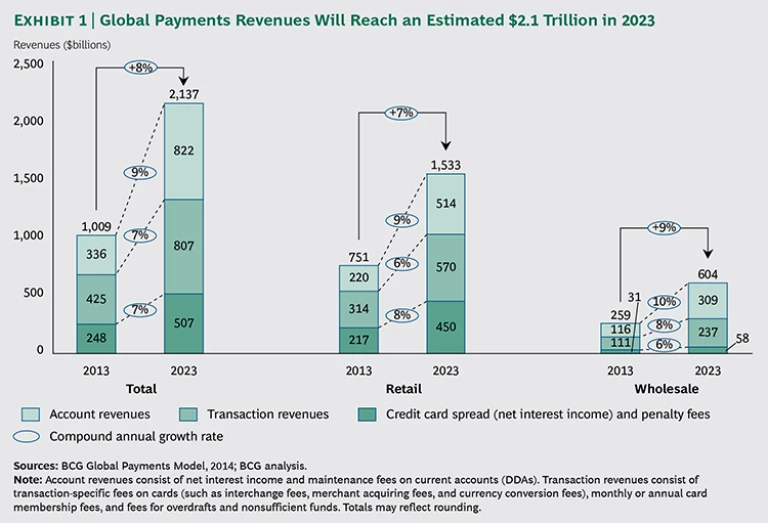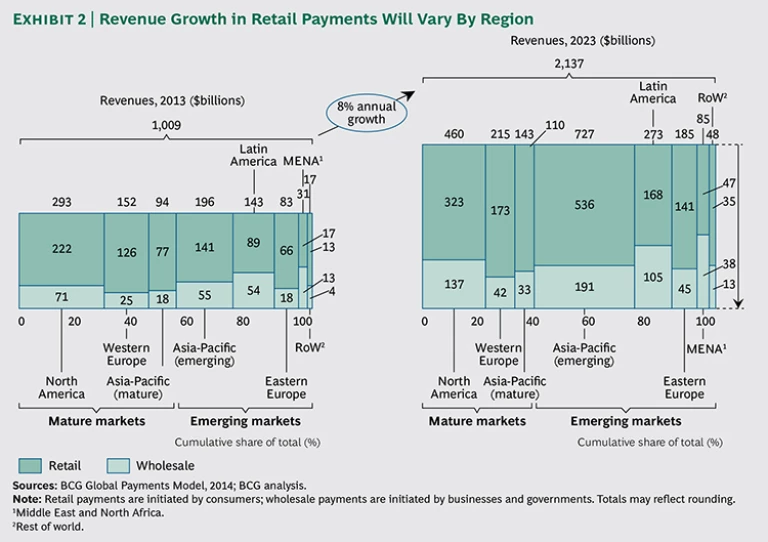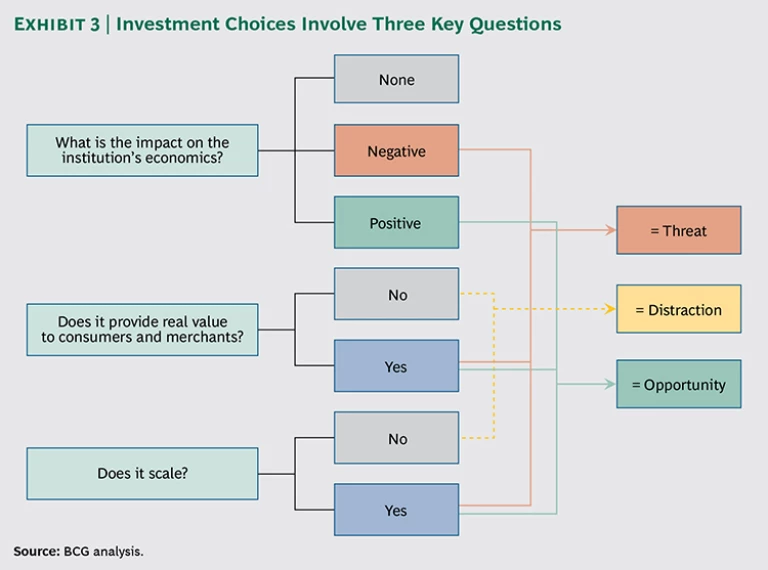The payments and transaction-banking businesses continue to represent vital elements of the banking industry and the global financial-services landscape. The importance of these businesses both as critical sources of stable revenues and as the foundation of customer relationships and loyalty has grown steadily in recent years and shows no signs of slowing down. The growth in payments and transaction banking, moreover, is driving stiff competition among not only traditional players but new entrants as well. Consequently, financial institutions must differentiate themselves, refine their strategies, and raise their execution skills if they want to remain competitive.
Global Payments 2014
In this twelfth edition of The Boston Consulting Group’s Global Payments report, we offer a comprehensive overview of the industry. We then take a regional approach to Retail Payments: Regional Diversity Is the Key —exploring the most important trends in Europe, North America, and rapidly developing economies (RDEs, also commonly referred to as emerging markets)—before closing with a global examination of the Wholesale Transaction Banking: Attaining Execution Excellence . In preparing this report, we have for the third consecutive year collaborated with SWIFT, the global provider of secure financial-messaging services.
This year also marks the debut of BCG’s Global Payments Model Interactive, which explores how regions and segments of the payments market will shift from 2013 through 2023. The interactive provides extensive detail on the volume and value of noncash transactions worldwide. ( View the current version of the interactive .)
We define payments revenues as the direct and indirect revenues generated by noncash payment services (excluding interbank transfers). They are the sum of the following:
- Account revenues: spread income on current account balances (also known as checking or demand-deposit accounts) and account maintenance fees
- Transaction revenues: transaction-specific revenues on cards (interchange fees, merchant acquiring fees, and currency conversion fees for cross-border card transactions); fees per transaction on a percentage or fixed basis for noncard payment types; fees for overdrafts and nonsufficient funds; and monthly or annual card membership fees
- Credit card spread (net interest income) and penalty fees
Retail payments are transactions initiated by consumers, and wholesale payments are transactions initiated by businesses or governments.
This year’s report incorporates two new revenue components: net interest income and penalty fees on credit cards as well as merchant acquiring fees. These additional revenue sources represented nearly $300 billion in revenues in 2013, or 30 percent of total payments revenues. All told, payments revenues were approximately one-quarter of total global-banking revenues.
Our aim in Global Payments 2014: Capturing the Next Level of Value is to provide institutions that are active in the payments and transaction-banking businesses with a solid understanding of major changes shaping the industry, as well as with our perspectives on the underlying drivers. We also offer recommendations on which specific actions should be taken by various types of players in order to achieve or maintain market-leading positions. In today’s ultracompetitive “new new normal” environment, no institution can afford to stand pat.
Overview: Strong Growth Is Poised to Continue
We expect the next ten years to continue to bring substantial growth in the payments and transaction-banking businesses. But these years will also bring disruptions, as economic models shift owing to digital technologies, regulation, intensifying competition, and new market entrants challenging incumbents. The many faces (and interfaces) of payments will change as successful innovators gain market share.
The $2 Trillion Prize in 2023
In 2013, payments businesses generated $425 billion in transaction revenues, $336 billion in account-related revenues, and $248 billion in net interest income and penalty fees related to credit cards. The total represented roughly one-quarter of all banking revenues globally. Banks handled $410 trillion in noncash transactions in 2013, more than five times the amount of global GDP.
Looking ahead, overall growth will maintain its positive trajectory. The value of noncash transactions will reach an estimated $780 trillion by 2023, a compound annual growth rate (CAGR) of 7 percent. Payments revenues will reach an estimated $2.1 trillion, a CAGR of 8 percent. (See Exhibit 1.) Retail payments businesses will dominate, led by account revenues and followed closely by credit cards. Wholesale transaction banking will see significant increases in revenues from account spreads.
Revenue growth in retail payments will vary by region. (See Exhibit 2.) RDEs are projected to achieve double-digit annual growth and to account for an estimated 77 percent of total retail revenue growth from 2013 through 2023. These markets are benefiting from rapid GDP and income expansion, relatively young and dynamic populations, and active government involvement in building payments infrastructures and enabling financial inclusion. The migration of cash to cards and to e-payments will open numerous opportunities for payments players.
By contrast, developed regions are projected to achieve a much lower annual growth rate of 4 percent. These regions continue to be challenged by narrow margins, the maturation of payments products, and modest economic growth. Compounding the systemic trends, various regulatory measures have been or will be implemented that significantly reduce revenues. For example, a regulatory tidal wave has already hit the United States, one that was fully reflected in 2013 revenues. In Europe, two waves are in force: first, the Single Euro Payments Area (SEPA) has resulted in gradually declining prices for certain payments products; and second, limits on interchange are expected to take a significant toll, resulting in €8 billion in lost revenues annually beginning in 2015. Payments stakeholders in developed European markets must therefore weather the regulatory storm and forge new business models to fill the revenue gap.
On the wholesale side, transaction-related revenues have tended to track economic and trade growth, whereas account revenues have faced a tug of war—pulled up by rising bank balances and pulled down by shrinking spreads. Account revenues are expected to recover, however, contributing roughly 56 percent of total wholesale revenue growth from 2013 through 2023.
Winning the Digital Game
Never in the history of the payments industry has there been a time of such disruption and opportunity across regions. Digital technologies will upset the competitive order and the role that payments play both in the operations of businesses and in the daily lives of consumers. Payments players, depending upon their strategic decisions over the next ten years, will have much to lose or gain. First, they must see payments as a platform, not simply as a product. Second, they must identify the initiatives that warrant investment. Third, they must pursue multiple paths in order to gain both broader experience and new customer insight.
Seeing Payments as a Platform. The digitization of banking and overall retail commerce is driving innovation in payments services. Mobile banking is enabling financial institutions to interact with their customers as often as they like and to deliver new services in real time. These capabilities are providing an unprecedented opportunity to improve customer satisfaction and deepen relationships. At the same time, technology companies are entering the payments space and generating new sources of value by integrating payments into broader platforms for merchants and consumers. These companies are engaging with their customers on a daily basis and pushing their payments capabilities. Incumbent players must figure out how to integrate their own payments services into platforms that contain additional benefits. Examples include Simple, PNC Bank’s Virtual Wallet, and BankAmeriDeals. If incumbents fail to act, they risk being relegated to the back end of the process (as has been the case with PayPal).
Identifying Initiatives That Warrant Investment. Financial institutions must evaluate numerous potential initiatives, including those related to digitization, to find the ones that merit their attention and investment. This endeavor is best approached using a framework that poses three key questions. (See Exhibit 3.)
- What is the impact on the institution’s economics? Players must determine whether a particular initiative will have a positive impact, improve the economics of certain customer segments, increase (or decrease) interactions, and create a new revenue stream. The effects on risk and fraud exposure, along with the cost of risk management, must also be considered.
- Does it provide real value to consumers and merchants? Of course, the key criterion here is whether the initiative truly eases a pain point or provides a better value proposition, taking into full consideration how customer needs and expectations are evolving outside of payments.
- Does it scale? It is also critical to examine whether an initiative offers economies of scale or a potential network effect. Part of the scale requirement is ensuring that the product or service either fits with current consumer behavior or has a sufficiently compelling value proposition to alter that behavior.
Pursuing Multiple Paths. Once a bank identifies the right initiatives, it has to make tough choices regarding which ones to pursue and whether to build or buy—or to seek partnership arrangements. Because digital payments solutions are still in a relatively nascent stage, banks need to build their knowledge through smart experimentation. We encourage them to participate in multiple initiatives and pursue both solo efforts and partnerships. Indeed, a few banks are adopting a technology-company approach. One leading institution, for example, is upgrading its mobile-banking platform every 100 days.
Moreover, while much of the investment in digital solutions has been in the
Ultimately, with more than $1 trillion in payments-related revenue growth as well as increasingly rapid development of digital technologies anticipated over the next ten years, banks have an enormous opportunity to increase revenues. But this prize will not be easily won. Banks must develop a long-term growth strategy that extends beyond payments, one that includes a new approach to product development and innovation. In the following sections, we will address these topics on a regional level for the retail segment, and on a global level for the wholesale segment.












